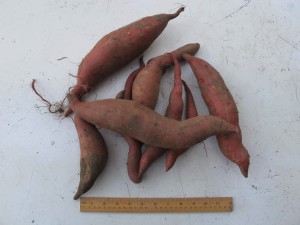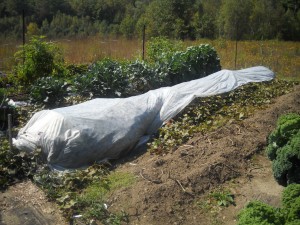Successes in the Garden
We had a cool, wet summer this year, and tomatoes were a disappointment. If you read this column regularly, you may know that my zucchinis were a bust. I did get some cukes, but like most gardeners, I didn’t have big yields – not enough to bother making pickles. Pumpkins ? Zippo. It would be easy to focus on those failures, but instead I want to share my successes – and hope you had some, too.
After a 15 year hiatus, I grew sweet potatoes this summer, and they were wonderful! Easy, productive and tasty! What more could a gardener want? When I tried them once before, I did not get much production, so I asked an expert before starting over. I called Geo Honninger of Hurricane Flats Farm in South Royalton, VT. Geo is an organic gardener who does real well with sweet potatoes and sells them at various farmers markets in my region.
Geo said that sweet potatoes love rich soil, plenty of moisture, and most of all, heat. To do that in this climate takes some extra effort. He advised me to grow them in mounded raised beds (my normal way of planting) and to cover the beds with black plastic (which is not something I would normally do). The plastic absorbs the sun’s heat, and radiates it down through the soil to the roots. On a year like this, that was very important.
I mixed plenty of compost into the raised bed and ran a soaker hose along the surface so that I would be able to get water to the plants after the black plastic went down – the plastic keeps most rain water out.
Last spring I ordered “slips” of a sweet potato called Beauregard from Johnny’s Selected Seeds (www.johnnyseeds.com). Slips are anemic-looking little plants with some root and a little bit of stem and leaf. Not impressive at all, I had my doubts. Geo told me to rip a hole in the plastic every 18 inches or so, and plant a slip in each hole. I stirred in a little Pro-Gro organic fertilizer for each plant. I used a hand trowel to create the hole and planted the 8-inch long slips straight down.
Finally I set up wire hoops about 4 feet apart and covered everything with row cover, and pinned down the edges to keep it from blowing away. Row cover is an agricultural fabric that breathes, but keeps in the heat and keeps out the bugs – though sweet potatoes are not bothered much by insects or diseases. Row cover allows moisture to pass through, but most rain rolls off the surface.
The vines filled up the space under the row cover, crawled out and got into the walkways. My watering system failed early in the summer, but that didn’t seem to matter. I guess water reached the plants by capillary action, absorbing it from the wet soil in the walkways.
The slips come in bundles of 25, 100 and 1,000. Not knowing how they would do (and not having much space) I opted for 25 plants, and 24 of them grew very well. A bundle of 25 costs $18.25 and fortunately, I had some black plastic and row cover in my barn. Still, it was more expensive than planting carrots or kale, that’s for sure. But the pay off was huge: I got about 60 pounds of food for the winter in a 32-foot row.
According to the Johnny’s catalog, I should have cured the sweet potatoes for 4-7 days unwashed in a well ventilated place with a temperature of 85 degrees. I didn’t do that, but even if I had read the recommendation, I don’t have such a place. But I do know that sweet potatoes should never go in the fridge. They should be stored in a humid, dark place at 60 degrees. The best I can come up with is to store them in brown paper bags in the house. My cellar is humid, but too cool.
What else did well for me? Celery root, also called celeriac, loves wet soil, so they did well. Bush beans were great – but I had low germination for my pole beans.
I got a pretty good crop of hot peppers, too, a French variety called Espelette. I wrote earlier that I tried planting some in the cavities of cement blocks. I’d heard that the blocks provided extra heat at night – which peppers love. I did some in blocks, and they produced peppers earlier than those planted in the ground. But the peppers planted in the ground ultimately produced many more fruits than those in cement block, so I won’t bother using blocks next year.
Growing your own food is a lot of work, but great satisfaction. And I know that I won’t get a big harvest of everything every year. But when I dug up the first sweet potato plant and pulled 3 one-pound potatoes I yipped and hollered like a boy who’d just gotten a brand-new red Schwinn bike.
Henry Homeyer is the author of 4 gardening books and a children’s fantasy-adventure about a boy born with a mustache and an ability to speak to animals. Learn more at www.henryhomeyer.com




